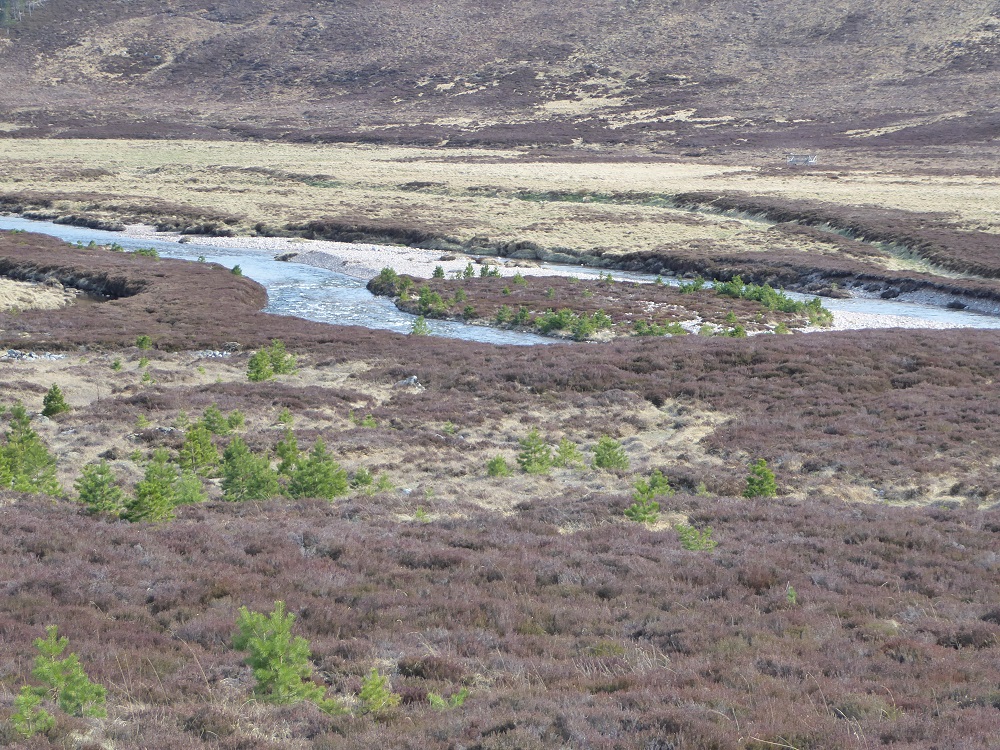
Last week (see here) I argued that the Loch Lomond and Trossachs National Park’s Trees and Woodlands Strategy is not a strategy at all because it contains no plans for how it intends to achieve its proposed vision and objectives. In effect its simply a vision with some guidance for landowners, including Scottish Ministers who, through Forest and Land Scotland, are by far the largest landowners in the National Park. The deadline for responding to the consultation has been extended from 3rd to 10th June (see here).
The online response form comprises fixed questions which ask whether you agree or not with the vision and eight objectives set out in the documents. Only yes/no responses are allowed and unless you do this you cannot make comments on the questioned concerned. Most of the vision and objectives sound very worthy so are hard to disagree without sounding unreasonable. The likely consequence of is the LLTNPA will be able to report that almost all consultees agree with the strategy. Its been designed as a self-fulfilling prophesy. This, however, won’t change the fact that the strategy, as a strategy, is vapid and unlikely to change anything.
I hope more organisations and people will respond to the strategy but do so informed by their own knowledge and experience of how woodland in the National Park is managed at present and how it ought to be in managed in future, rather than being led by the questions the LLTNPA is asking.
This post takes a more detailed look at the sort of plans the Strategy should be developing for native woodland. Its based on the example of the Caledonian pine forest in the National Park.
The Caledonian pine forest remnants in the National Park
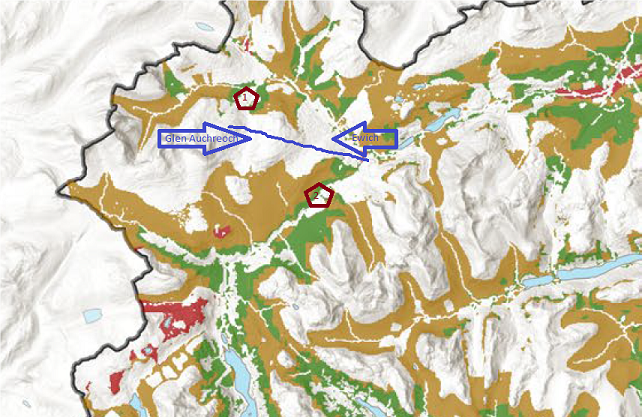
There are two remnants of the former Caledonian pine forest within the National Park, at Coire Chuilc off Cononish Glen and in Glen Falloch.
The Glen Falloch pinewood (see here for info from SNH) marks the southern limit of the former Caledonian forest and is unusual in that pollen analysis from peat shows it developed about 4,300 years ago when pines had started to retreat elsewhere in Scotland. Coire Chuilc (see here for info from SNH) was designated a Sites of Special Scientific Interest in 1974 and Glen Falloch in 1981. For thirty years (over)grazing of the woods by both deer and sheep continued, preventing the pinewood from regenerating. The creation of fenced enclosures proved remarkably ineffective, apparently because fences were not properly maintained. In 2008 both pinewoods were assessed as being in “unfavourable condition”. With almost no young trees – those in Glen Falloch were between 120 and 400 years old – the woods were at risk of dying out completely.
Here’s an extract from SNH’s Management statement for Coire Chuilc:
“To date, woodland regeneration at Coille Coire Chuilc has generally been poor and it is essential that this is improved to ensure the continuation of the woodland.
The most significant factor thought to be inhibiting regeneration is grazing pressure. Therefore it is essential that stock and wild herbivore levels within the wood are low enough to allow the successful regeneration of native tree species. The growth rates of pine saplings appear to be very slow here but the current grazing levels to the west of Allt Gleann Auchreoch are thought to be just low enough to allow the currently established saplings to get away. To the east of Allt Gleann Auchreoch regeneration cannot be expected without a reduction in sheep browsing pressure to allow some established young pine to develop. Priority should, however, be given to the west section as many of the mature pines in this section are beginning to degenerate and reaching a stage where they will no longer produce viable seed.”
The failure of the landowners was so serious that the RSPB was given seed from the pines to plant a new native pinewood above the oakwoods on their Inversnaid Reserve.
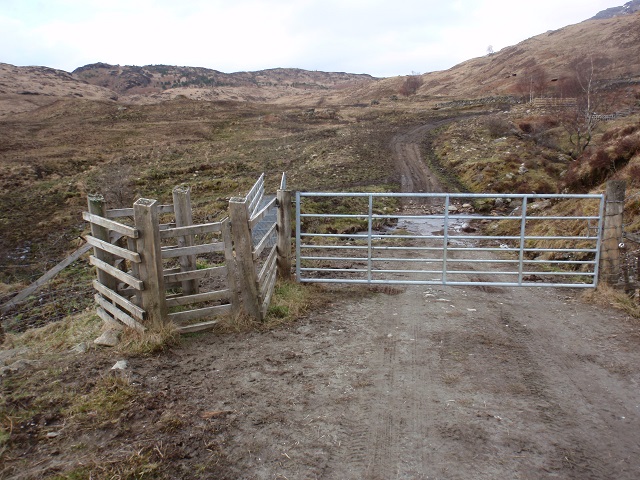
From 2008, however, more resolute action was taken to protect the pinewoods. There was some planting of pines in Glen Falloch – contrary to the commendable aspiration in the LLTNPA’ draft Trees and Woodland Strategy that old woods should regenerate naturally – and more effective fenced enclosures were created. On both sites vegetation and trees now appear to be recovering, although there is still a long way to go. Moreover both sites form small islands of native pinewood within a wildlife desert created by overgrazing and conifer plantations and there appear to be NO plans to expand them further.
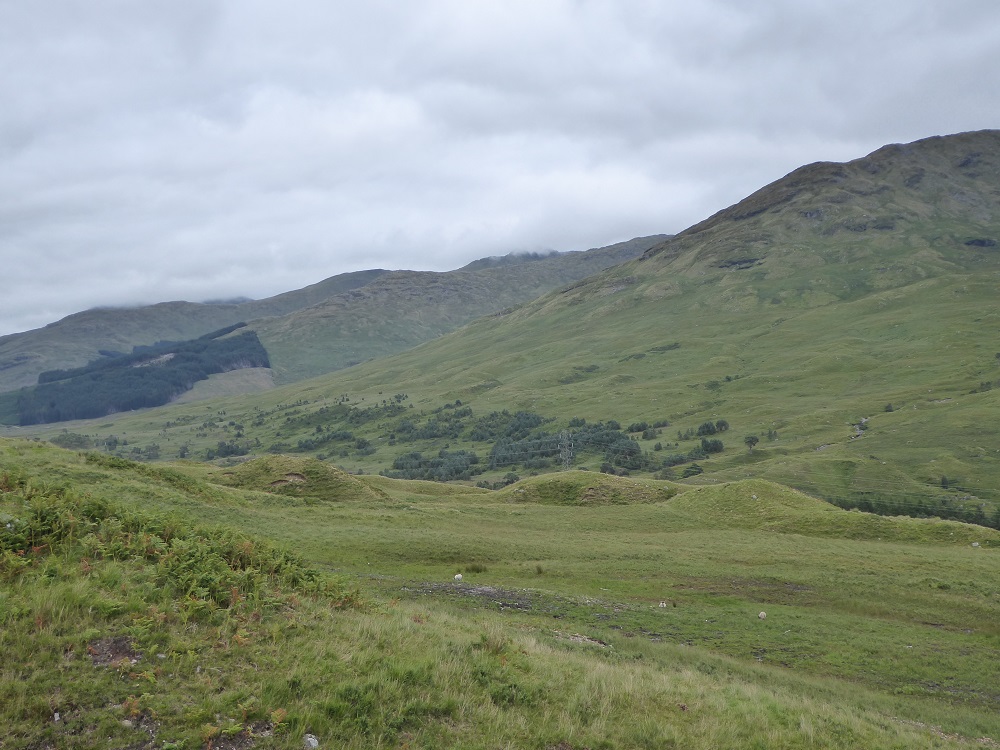
How to link the two Caledonian Forest remnants?
The Trees and Woodlands Strategy explicitly mentions the importance of habitat networks:
Woodland Habitat Networks
Habitat networks are areas of habitat that are connected in such a way that dependent species can disperse between the areas to create linked populations. A healthy and sustainable habitat network
enables species to be more resilient to environmental changes.
This is of great relevance to the two fragments of Caledonian Forest in the Park both of which are far too small to support the range of species found in Glen Affric or the Cairngorms (e.g Crested Tit or Capercaillie). The woods need to expand to be able to support a wider range of species and connecting them should be quite possible with a bit of imagination and determination as they are just 6km apart as the eagle flies. A proper plan from the National Park could provide a demonstration of how to connect the various pinewood fragments north of Glen Falloch (Glen Orchy, Loch Tulla and at Crannach, west of Beinn a Chreachain).
Unfortunately, while the Strategy describes connecting the pinewood areas is a priority, what is says is contradictory and there are no plans about how to achieve this priority:
“Caledonian Pinewoods
There are two remnant areas of ancient native pine woodland in the National Park and the expansion and improved connectivity of these areas is a priority.”
Comment: agreed
“Current guidance is that expansion from these core areas into their buffer areas should be by natural regeneration of Scots pine in order to minimise the risk of Dothistroma Needle Blight infection. The inclusion of native pine in the design of restocking proposals would improve connectivity of these remnants, in terms of habitat and landscape, so would contribute to this objective.”
Comment: the second sentence, which says pine should be included in restocking proposals, contradicts the first which says the expansion of core areas of pine forest should be by natural regeneration. Elsewhere the Strategy suggests that natural regeneration is not just to prevent needle blight infection but:
“To ensure species of appropriate provenance and to avoid the risk of introducing pathogens via planting stock (e.g. Dothistroma needle blight in native pine woodland areas), natural regeneration is the preferred means of expanding woodland cover within or adjacent to designated sites. Planting will
only be considered where it can be demonstrated that this is consistent with maintaining or enhancing the interests of the site and appropriate planting stock can be obtained (increased species diversity might be desirable in some circumstances). These principles also apply to proposals for woodland
expansion within or adjacent to ancient woodland”.
Does this tell the public what is likely to happen around Coire Chuilc or Glen Falloch? Without proposals for action it is meaningless. Why produce guidance on natural regeneration of pinewoods unless someone is going to do something to make this happen? It also makes little sense for areas around native woods which are currently planted with conifers and where planting of native trees is unlikely to create any further damage to soils. One of the main arguments for Natural Regeneration, which is missed in the woodland strategy, is to protects soils and not plant trees should be the primary means of native woodland expansion where soils are undisturbed
The SNH map on sitelink, which shows both SSSIs AND plantation forestry, illustrates what needs to happen far better than the maps published in the LLTNPA’s woodland strategy:
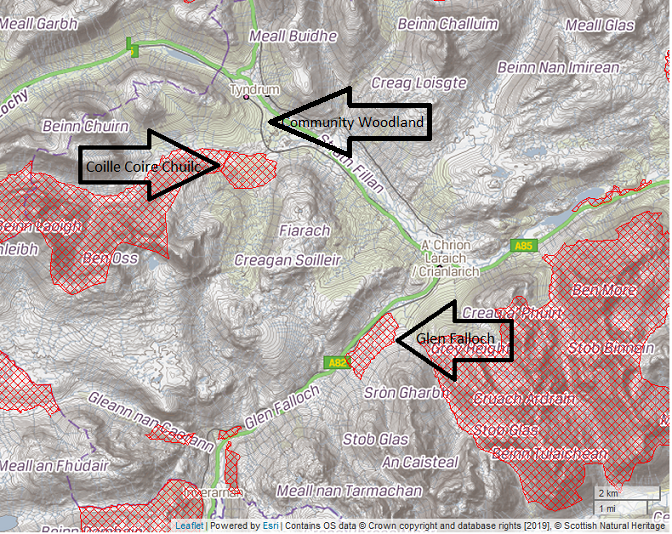
The main challenges to connecting the Glen Falloch and Coille Coire Chuilc woods, which could with will be done entirely through natural regeneration, is first overgrazing and second the swathes of conifer forest separating them.
This is well illustrated in the case of Coire Chuilc by the view on the ground:
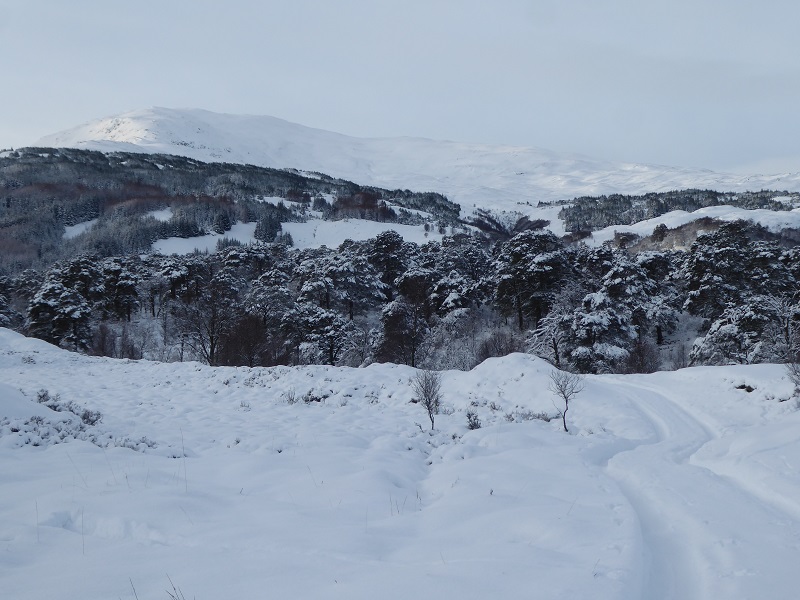
The Coire Chuilc pinewood is half surrounded by plantation forestry, though the Tyndrum community woodland is not far away to the north east. Plantation forestry, as the SNH site management statement says – something that is again not mentioned in the woodland strategy – creates its own risks:
Although not a significant problem at present, vigilance will be needed to ensure saplings of Sitka spruce from the adjacent plantations do not become established within the SSSI.
With Beinn Dubhcraig to the south, there is very little room for Coire Chuilc to regenerate naturally UNLESS the surrounding sitka plantations are felled, the land there restored and grazing levels then strictly controlled (as Glen Feshie are doing in the Cairngorms).
This presents some challenge as there appear to be three different landowners whose property adjoins Coire Chuilc. There is NOTHING in the Trees and Woodland Strategy about how the LLTNPA and Forestry Scotland will persuade private landowners to allow native woodlands to expand through natural regeneration. This would require reform of the woodland grant system which is based on fencing and planting and provides no payments for natural regeneration or keeping deer numbers down.
Forest and Land Scotland, however, does own the Ewich forest (top map), taken by the West Highland Way as it heads north from Crianlarich. That forms part of the barrier between the two native pinewoods and potentially could help link them.
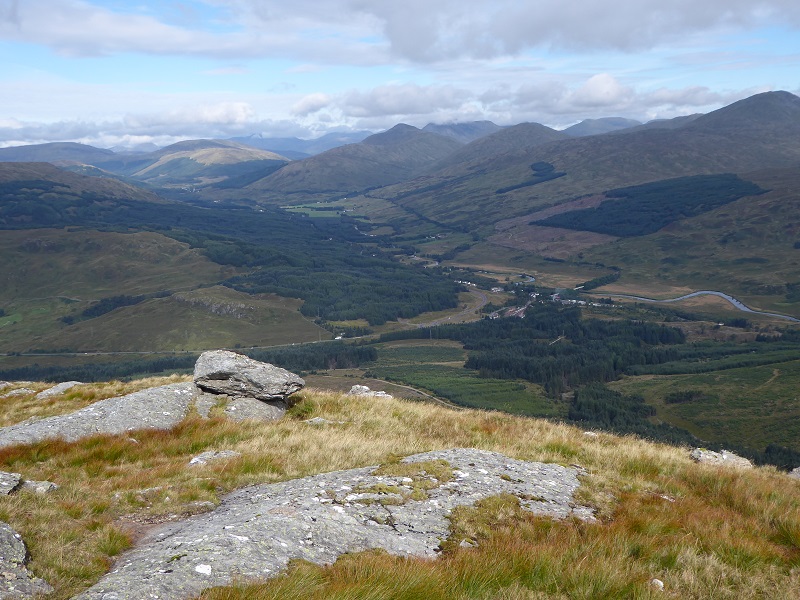
Replacing Ewich forest by native pinewood would also help to improve the West Highland Way after Crianlarich. The section through the conifers possibly provides the single worst walking experience along the whole of the West Highland Way.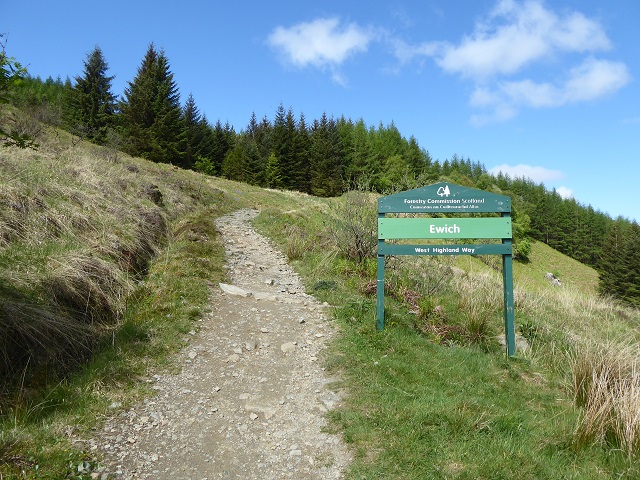
The West Highland Way disappears into the Ewich Forest for 3km. Native pinewood would provide a far superior walking experience.
An alternative way of linking the fragments would be to follow the example of the Cairngorms National Park Authority which has made an explicit commitment to connect native woodland over watersheds. With plantation trees growing in Gleann Auchreoch close to the watershed with the Eas Eonan, which flows down into the Falloch, it should be quite possible to connect the two fragments of pinewood by a fairly direct route.
That would mean, however, reaching agreement with Falloch Estates that they should radically reduce grazing levels. It would also mean persuading the owners of the Auchreoch forest, who appear to be a company based in Jersey, to put profit second or sell the land. That could be done, however, through encouraging a community buyout, with the local community at Tyndrum having already established a community woodland where Cononish Glen meets Strathfillan.
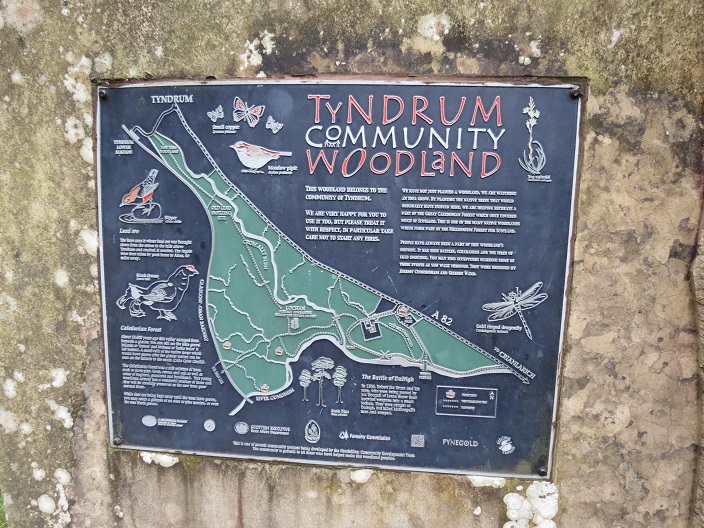
What our public authorities could do to make this happen
Our Public Authorities have all the powers necessary to make this happen, given the will. Scottish Forestry, as provider of grants, could refuse to countenance any restocking of Glen Auchreoch once the sitka there is felled and create the opportunity for the local community to take over the land. The LLTNPA has powers to make byelaws for nature conservation and could also use its planning powers to much better effect. SNH has powers to control deer numbers as well as to enter into management agreements for protected areas. Despite all this, while there is only wishy washy guidance and no high level plan committing the agencies to connect these two remnants of Caledonian Forest nothing is likely to happen.
In the case of the LLTNPA this is illustrated by the recent history of hydro planning applications in Glen Falloch. As part of hydro planning consents, the LLTNPA did require a few new areas of native woodland to be planted in the glen.
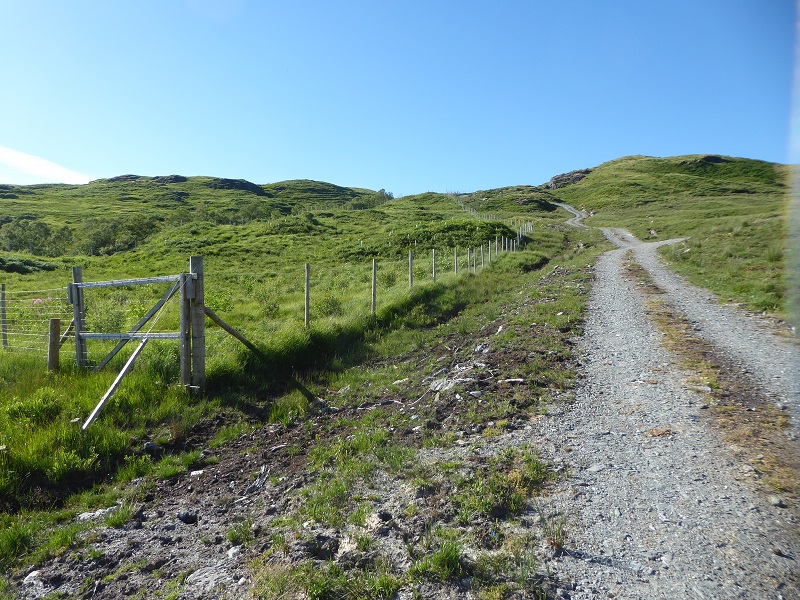
The planting along the Eas Eonan could help form part of the habitat network over the watershed between the Glen Falloch and Coire Chuilc pinewoods. Unfortunately, no pine trees appear from the photo (or my memory) to have been planted here.
Most the tree planting associated with the hydro schemes has been to screen the hydro powerhouses:
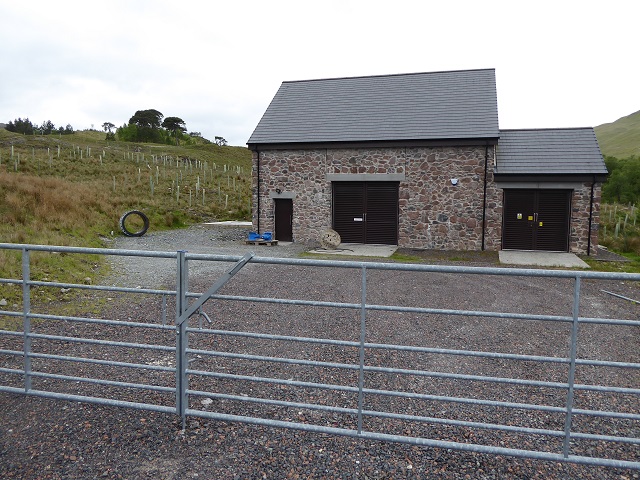
The Woodland Strategy identifies natural regeneration as being the preferred method of expanding designated woodland sites just a couple of years after the LLTNPA has promoted planting adjacent to such a site! Here was an ideal opportunity either to bring grazing levels down or, if a fenced exclosure really was the only option, to create a fenced area extending to the pinewood. Instead this, the consequence of a lack of plans and evidence that guidance by itself will never deliver joined up thinking.
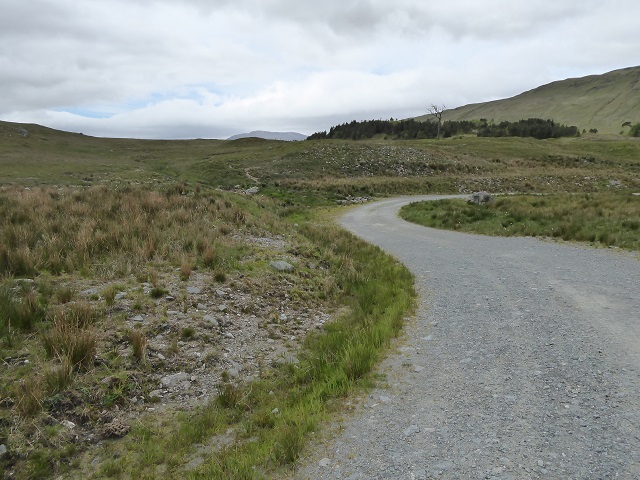
If you accept that some hydro schemes might have been appropriate in Glen Falloch (if better designed and executed), the lost opportunities are enormous. Trees won’t grow everywhere and naturally give way to peat on waterlogged ground. By undergrounding the pipeline and creating a large road for construction purposes, the ground here has been totally changed and now resembles something like the mineral soils that were present as the glaciers retreated. It was those soils which enabled pinewood to flourish and it would do so here, with a handy seed source nearby, if only grazing levels were brought down.
The regeneration of the pinewood would also have been a way of hiding the landscape impact of all the new roads in Glen Falloch (though even if that happened I still believe they should be narrower than they are at present). In consenting the four major power schemes in Glen Falloch the Scottish Government, and the LLTNPA who advised them and approved the subsequent applications to retain the hydro roads, had a major opportunity to use the planning system to enable the Falloch pinewood to expand. Unfortunately they failed to do so.
Part of the reason for this is that there was no proper plan in place for the expansion of the Glen Falloch pinewood. Had there been so, the LLTNPA could have used the planning system to help achieve its conservation objectives. That’s why the LLTNPA’s Woodland Strategy needs to be fleshed out to include clear high level plans for woodland restoration.
Over in Cononish Glen there are similar questions about how the planning system can be best used . A condition of the LLTNPA granting planning consent to the Cononish goldmine was that it should plant native woodland “in mitigation”. Unfortunately, that does not seem to have been made as part of a coherent plan for how the Coire Chuilc pinewood might expand to the north, though it has the potential to close the gap between the Coire Chuilc wood and Tyndrum Community woodland
What needs to happen
The issues and solutions to the question of how to expand and connect the Coire Chuilc and Glen Falloch pinewoods are, I believe, applicable to areas of native woodland across the National Park and beyond. This post has shown the question of how to restore native woods is complicated and argued that because of this high level plans are needed to make things happen. Guidance and leaving decisions to the “forestry” market is not enough.
Part of the problem here is not the LLTNPA but the state forestry industry. Both Forest Enterprise Scotland, which operated the forest estate in the National Park, and the Forestry Commission Scotland, the regulator, failed to publish the information they hold as part of the consultation. I suspect this was because they were reluctant to allow the many Forest Plans that have been developed in the National Park to be considered as a whole. That would have enabled people to challenge the priorities they have set for existing forests. Their successors, Forest and Land Scotland and Scottish Forestry should now do so.
The other problem, however, concerns new native woodland creation. The maps produced for the Strategy consultation are of very little use because they do not show the relationship between existing woodland, whether native or industrial forestry, and “preferred” new native woodland areas. Its impossible therefore to get any sort of strategic understanding of what is being proposed for specific areas or the National Park as a whole and how it all fits. The Glen Falloch/Coire Chuilc example shows this is sorely needed. I hope that the LLTNPA Board will insist on comprehensive maps being produced as part of any final woodland strategy and that they use this to identify priority areas for delivery plans that might actually deliver some of the aspirations of the Strategy.
The development of such plans will require additional staff resources. I suspect the LLTNPA are only too aware of this which is why the Strategy has been written as a guidance document. Guidance is cheap, effective action requires resources. Instead of running away from the resource issues, the LLTNPA should be making the case for investment in conservation. The Woodland and Trees Strategy would be a good place to start.
I too read the Woodland and Trees Strategy and was keen to participate in the ‘Consultation’. However, like you, I found that though there was little I could disagree with except that there was no actual plan for delivery or timescale. I find myself reluctant to just tick yes or no. I also feel reluctant to add comments. I remember the ‘Your Park’ ‘Consultation where it was evident that from the results that if I ticked yes but added a ‘wish list’ of the negatives the response appeared to be taken as a straight YES. However, where NO had been ticked with some positives added as comments, it appeared to taken by NPA as a YES. As I remember the numbers of responses didn’t even tally and there was 1 undecided!! An interesting statement in the March NPA Board papers – native and non-native trees would be planted. Why then were the Beech trees decimated on Inch Tavannach on Loch Lomond?
I agree with your basic criticism that a plan that lays out aims, what might be called a vision building exercise if properly done without identifying the how to realise that vision is simply not a strategy – or even a vision. It is simply a wish list that lets the initiators “tick the box.” When the consultation procedures predetermine the aims without first encouraging an open-ended response seeking the ideas of others, it breaches guidelines on consultation even from government (As in “Listen Up”) and limits devalues the whole exercise. When done without first clear reference to what LLTNPA and others can do, it becomes a bit futile.
I can provide some background to the (fairly) recent history of the pines of Glen Falloch. In 1978 I was a final-year BSc student at Edinburgh U., and for my thesis I studied rates of inbreeding among the residual pines at GF. I collected seed from almost every remaining tree (144 of them, from memory, at that time; a few on the edge of the ravine were too inaccessible to collect from). Having grown the seedlings in the greenhouse at Edinburgh, I didn’t want them to be discarded, so I worked with the then-Nature Conservancy to raise money (most generous donor was “Men of the Trees”) to erect the first exclosures on the site, which happened in 1981 or 2, and plant out the seedlings raised from the local trees. I’m not sure if these trees are the ones you refer to as “some planting”; if so, I can assure you they were all local.
My career took me away from the UK, so I was rarely able to revisit GF, but did so in around 2012, when I was delighted to see that the original exclosures had been expanded, and that there was excellent regeneration of pine, birch, rowan, etc. within the exclosures. I was surprised to read, therefore, that these were “remarkably ineffective, apparently because fences were not properly maintained … in 2008 both pinewoods were assessed as being in ‘unfavourable condition’… with almost no young trees”.
Anyway, I certainly support the aspiration to link GF with Coire Chuilc, and in general with the rewilding of the NP.
Thank you for providing this information, so interesting to read. I was searching for information on the management of the Coire Cuilc Pine reserve after walking through it recently and being dismayed at the condition, the grazing pressure and lack of fencing. It pains me that this southern remnant of the Caledonian Pine forest is not being looked after as it should and I would love to find ways to support action to create better management, whether through community buyout (as you mention) or supporting the landowners to fence and manage the woodlands. As a resident in tyndrum and part of the community trust I feel that we should be honouring and stewarding these precious habitats in our area.
Hi Kelda, if deer numbers were low enough, probably 2 per square km, there wouldn’t be a need to fence and the pinewood would be able to expand its are through natural regeneration. I think the challenge therefore is creating mechanisms so that whoever manages the land, either private landowner or local community is rewarded for keeping deer numbers down. Nick